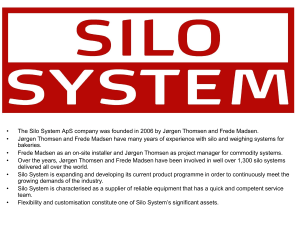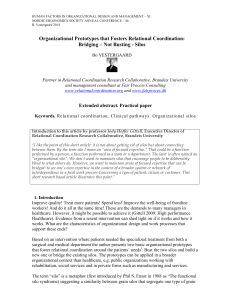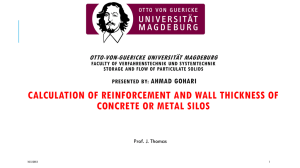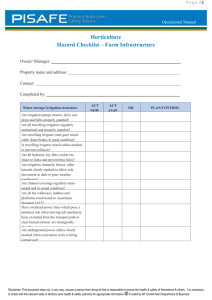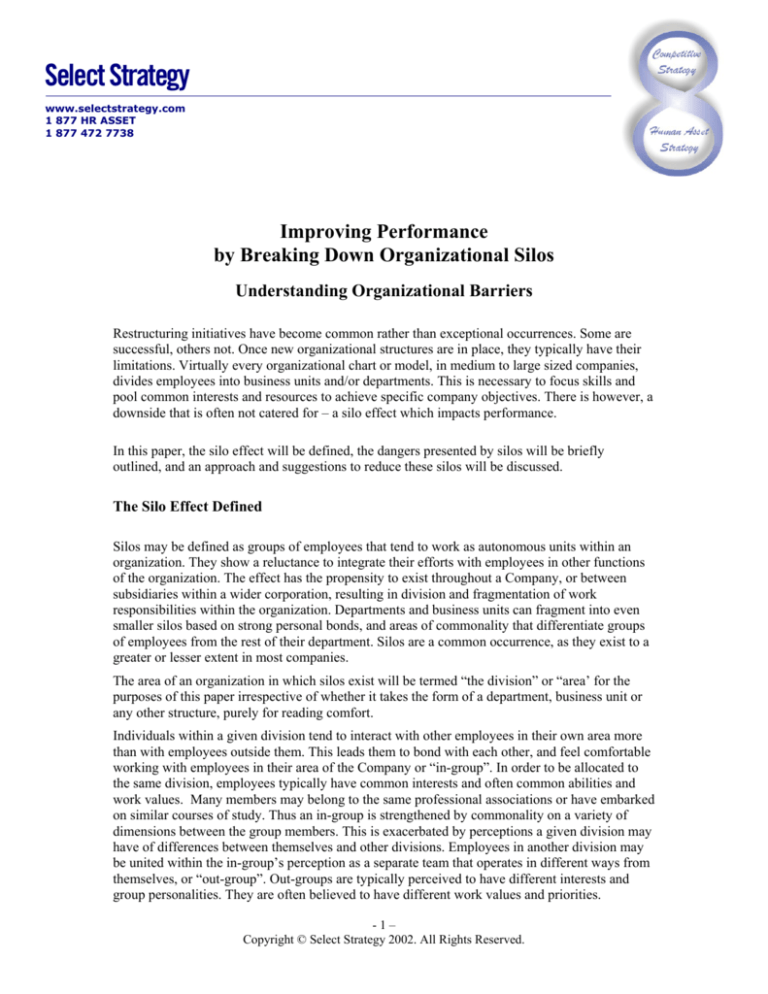
Select Strategy
www.selectstrategy.com
1 877 HR ASSET
1 877 472 7738
Improving Performance
by Breaking Down Organizational Silos
Understanding Organizational Barriers
Restructuring initiatives have become common rather than exceptional occurrences. Some are
successful, others not. Once new organizational structures are in place, they typically have their
limitations. Virtually every organizational chart or model, in medium to large sized companies,
divides employees into business units and/or departments. This is necessary to focus skills and
pool common interests and resources to achieve specific company objectives. There is however, a
downside that is often not catered for – a silo effect which impacts performance.
In this paper, the silo effect will be defined, the dangers presented by silos will be briefly
outlined, and an approach and suggestions to reduce these silos will be discussed.
The Silo Effect Defined
Silos may be defined as groups of employees that tend to work as autonomous units within an
organization. They show a reluctance to integrate their efforts with employees in other functions
of the organization. The effect has the propensity to exist throughout a Company, or between
subsidiaries within a wider corporation, resulting in division and fragmentation of work
responsibilities within the organization. Departments and business units can fragment into even
smaller silos based on strong personal bonds, and areas of commonality that differentiate groups
of employees from the rest of their department. Silos are a common occurrence, as they exist to a
greater or lesser extent in most companies.
The area of an organization in which silos exist will be termed “the division” or “area’ for the
purposes of this paper irrespective of whether it takes the form of a department, business unit or
any other structure, purely for reading comfort.
Individuals within a given division tend to interact with other employees in their own area more
than with employees outside them. This leads them to bond with each other, and feel comfortable
working with employees in their area of the Company or “in-group”. In order to be allocated to
the same division, employees typically have common interests and often common abilities and
work values. Many members may belong to the same professional associations or have embarked
on similar courses of study. Thus an in-group is strengthened by commonality on a variety of
dimensions between the group members. This is exacerbated by perceptions a given division may
have of differences between themselves and other divisions. Employees in another division may
be united within the in-group’s perception as a separate team that operates in different ways from
themselves, or “out-group”. Out-groups are typically perceived to have different interests and
group personalities. They are often believed to have different work values and priorities.
-1–
Copyright © Select Strategy 2002. All Rights Reserved.
What Factors Contribute to Silo Formation?
Incompatible Objectives
In understanding silo formation it is important to realize that individual divisions often have
necessary, but conflicting priorities. For instance, an artistic department in a Company may have
artistic excellence, as its greatest priority, whilst the financial department may be concerned with
profit, and cost reduction or profit generating activities in the artistic department.
Meetings
In many instances it is easy and convenient for employees to restrict most intra-organizational
meetings within a daily schedule to their own division, and focus on its primary objectives. This
keeps employees in their comfort zones from both a social and work perspective. Conflict with
differing priorities associated with other parts of the organization, is avoided.
Incentives
There are often major incentives for an employee to restrict most personal interactions to their
own division. Employees generally report to members of their own division. Performance is
appraised and compensation determined based mostly on perceptions from within their division.
Work that is required of the employees may stimulate them to focus work efforts within the skill
pool of their own division. People sharing similar or complimentary skills may be repeatedly
allocated to the same tasks. It is often most viable to form professional networks within the
department of people who conduct similar work and belong to the same professional bodies.
Sub-cultures
Importantly, when left to their own devises, employees within an in-group form and entrench
their own sub-culture that becomes distinct from the rest of the organization. (The term “subculture” refers to the creation of new cultural characteristics within a subgroup of an
organization.) This sub-culture makes it increasingly difficult for other members of the company
to integrate into the group. Outside employees may have difficulty in understanding and
articulating this culture and be unable to conform to the social norms it requires.
Employees within a given division or in-group often socialize more with each other even at
communal office functions. Members of a given out-group may be and feel unwanted by the ingroup within a social context. Employees will tend to feel most comfortable in their own division
with their friends. Alternative sub-cultures are hard to crack, different and less inviting. Hence
organizational silos are created.
-2–
Copyright © Select Strategy 2002. All Rights Reserved.
Silo Formation
There are 3 types of influences that cause silos. Those internal to the silo itself, those imposed by
the Company and those that stem from the outside world. These three factors interact to form
silos such that each impacts the others, thereby reinforcing the silo system.
External Environment
Outside customer demands require focused
efforts & thought on work-related issues.
Organizational Influences
Company structures such as incentive systems
task allocation systems & office layout limit interpersonal
interaction & co-operation between departments
Internal Influences
Sub-culture is formed
based on
common knowledge,
skills, learning
& group experiences.
-3–
Copyright © Select Strategy 2002. All Rights Reserved.
Why Silos are Dangerous for an Organization
Communication Barriers
Silo formation is undesirable because it creates barriers to communication between divisions.
This facilitates divisions working in isolation, which negatively impacts the work process because
there is a lack of integration between functions. This is particularly serious in service-based
organizations that compromise on the ability to offer an integrated solution. In virtually every
Company where silo effects are present, various broad organizational objectives and goals are not
optimally achieved, because the collective brain power and work potential of the organization
cannot be fully harnessed.
Minimal Co-operation between Areas
Employees do not co-operate with and assist other departments in the Company as much as they
should, costing the firm time, effort and money. Importantly within a Company or Group that
offers a variety of products or services, employees may be reluctant to refer work to other sectors
of the Company. Given that the rest of the Company is not a priority for them, products and
services offered by other members of the Group may not be on their radar screens.
The Psychology of ‘Feeling a Victim’
There is broad recognition of a “communication problem” of which everyone feels a victim. This
is unfortunate because it is difficult for existing members of the firm to break down the
communication barriers in light of a pervasive feeling of helplessness. The individual employee’s
perception of the problem tends to be that it is insurmountable. Employees each feel that it is not
their fault and exists outside their personal control. The communication breakdowns lead to errors
and finger pointing, as employees want to distance themselves from errors, and avoid taking
responsibility for mistakes that could impede their career progression or credibility within the
Company. Anger is often directed towards certain people who are fairly or unfairly identified as
being at the root of the problem. Finger pointing will also tend to reinforce in-group out-group
psychology, as people prefer to antagonize members of other divisions and feel safer placing
blame further away from their own divisions.
Silos are Long Lasting
Once silos are constructed, they cannot be easily eliminated. People within silos have a
propensity to form lasting friendships. Their subcultures become entrenched. They often socialize
after hours with people within their silos and create a social distance between themselves and the
rest of the company. As time passes, this distance between silos becomes more difficult to
narrow.
-4–
Copyright © Select Strategy 2002. All Rights Reserved.
Why Silos are dangerous:
The downward spiral
Each division is focused on its own primary objectives
Divisions do not communicate sufficiently or effectively
because of the factors that feed into silo formation
Divisions do not co-operate with each other
because they are uninformed
The lack of co-operation breeds resentment and
a reciprocal lack of giving
Division members feel isolated from other divisions
and focus work effort within their own division
Each division focuses on it’s own primary objectives
-5–
Copyright © Select Strategy 2002. All Rights Reserved.
Overcoming the Barriers of a Silo Organizational Structure
Components of a Solution:
The Process
The elimination of silos is the end result of a process that begins with the articulation of a
definition and explanation of the silo situation within the given organization.
Employees need to be consulted and given the opportunity to offer suggestions on how to
eliminate the silos within the Company. This ensures that definitions and explanations are based
on optimal levels of information, communication and understanding. Also employees must be
consulted so that they agree in principle with the definition of the silo problem. Employee dissent
with components of the definition can cause unnecessary resistance to the process. It is important
that the formal definition is created with sufficient sensitivity to the integrity of individual
employees and in-groups. This prevents employees from constructing defensive psychological
barriers that inhibit the successful completion of the process. Such sensitivity can be achieved by
constructing the definition in broad terms as opposed to incorporating any point that would imply
personal responsibility. Firms can greatly increase the accuracy of data that goes into the
explanation by performing an organizational assessment that includes data gathering by means of
employee surveys, focus groups and individual interviews.
Once the problem is clearly defined, solutions must be carefully formulated around both the
needs of the Company and its employees. It is very useful while thinking about solutions to
define the points at which potential integration between silos could occur.
The most workable and practical solutions are then chosen from the list of options for adoption in
the organization. These selected solutions must then be communicated to employees.
The level of employee buy-in to the process is a factor that either enhances the success of an
intervention or undermines it. Solutions need to stand up to employee evaluation prior to being
adopted. The likelihood and extent of adoption is based on the practical strength and usability of
the solutions as well as the perceived desirability of the solution. In other words the likelihood of
the recommended solutions being accepted by employees is dependent on the:
•
•
•
employees’ perception of the merit of the solution
extent to which employees believe it impacts their interests
logistics of implementation.
Where the solutions impose disadvantages for employees, these can be compensated by the
introduction of new advantages from the process. This has to be worked out relative to the
practical situation at each Company.
In summary, to convince employees that it is in their interests to fight the silo effect, and that the
firm’s recommended solutions be adopted, the problem needs to be carefully defined and
solutions formulated in ways that are sufficiently attractive to employees to propel them to
embrace the process.
Some solutions are likely to be simple, other may be more complex to implement. There is also a
need to be flexible during implementation as unforeseen issues may arise that affect the silo
-6–
Copyright © Select Strategy 2002. All Rights Reserved.
elimination process. Therefore progress must be continuously evaluated and modifications made
if necessary.
Management Commitment
In order to eliminate the silo effect, management has to show a commitment to address the
negative effects of silos. The importance of the intended improvements needs to be
communicated to and internalized by every member of the company. Management needs to lead
by example and processes need to be set up to demonstrate their commitment to eliminating silo
effects to employees.
Messages from Management
Effective communication of the problem and solutions by management to employees is key to the
success of the process. There must be consensus on the course of action to be followed and the
ways in which it is to be communicated. Communication options include formal meetings,
written notifications, training and individual teaching. Management needs to model the
recommended behaviors and demonstrate their personal participation in and commitment to the
process. It is essential that sufficient resources within the Company be allocated to the process. It
must be clear where responsibility for leading the initiative lies. Senior employees selected to
head the initiative must be good teachers and managers, committed to the process and well
respected by other employees. Employee commitment may be compromised if management
commitment is questioned.
Organizational Objectives and Performance Evaluation
An imperative point on the list of solutions is to define overall company objectives (if they are
not already defined). These are communicated to employees, along with the employees’ roles in
achieving the stated objectives. The reason for this is to assist employees in recognizing common
ground. This acts towards minimizing the importance of perceived differences between divisions.
Employees must be evaluated within a performance appraisal process on their performance
relative to these broader organizational objectives.
Sample questions could include:
•
•
•
•
•
Does the employee make practical strides towards reaching (specific or broad)
organizational objectives?
Does the employee co-operate with organizational members outside of his/her
department?
Does the employee perform tasks that benefit the rest of the Company?
Does the employee attend meetings with members outside his/her department?
Does the employee facilitate the performance of teamwork that includes people outside of
his/her department?
In addition to these qualitative questions, quantitative measures should be put in place (where
possible) to assess whether employees have co-operated with other departments or Group
Companies, and acted towards maintaining a silo-free workplace. Incentive systems may also be
-7–
Copyright © Select Strategy 2002. All Rights Reserved.
structured to make allowance for credit based on performance on this dimension. Alternative
rewards can be put in place. A full explanation of the manipulation of performance appraisals and
use of incentive systems to motivate employees to move out of silos requires an in-depth
discussion beyond the scope of this paper.
Recognize Business Referrals
Within a Group that offers various products and services, it is ideal that referrals to other
components of the Group are recognized within the appraisal process. Ideally financial incentives
should be in place to facilitate this. The firm could work on a points system whereby points
would be allocated for a referral such that points accrue as credits towards a more substantial
incentive.
Culture Changes
In creating common ground, it may be desirable for a company to embark on broad organizational
culture changes and to break down some of the components of organizational sub-cultures that
inhibit optimal communication between divisions or optimal organizational performance. This
needs to be evaluated and the correct interventions determined on a case-by-case basis. Obviously
research would need to be conducted to understand the various sub-cultures to obtain effective
results. Cultures and sub-cultures are based on deeply embedded underlying assumptions. It is
important that these are uncovered and understood by both the employees within the sub-culture
and change agents if efforts to break down negative components of the culture are to achieve their
objective. Employees within the sub-culture must be able on a rational and/or emotional level to
realize the limitations that elements of their culture impose on them. These limitations must be
significant enough to the in-group to stimulate a desire for change.
Employees within a silo are only likely to accept solid solutions that solve the problem. These
must be present for change to occur. It is important for in-groups and the broader management
team to acknowledge that sub-cultures form over time as means of understanding the
environment and achieving objectives. They provide coping mechanisms that will not be
discarded lightly and without good substitutes. It may be counter-productive, threatening to the
in-group and unnecessary to try and disassemble the entire sub-culture. Psychological defenses
the perceived threat may elicit can inhibit the continuation of the process. Rather the focus should
be on eliminating the barriers that maintain silos and creating openness to other employees and
new learning.
Task allocation
Amongst the most effective ways of eliminating silos is the allocation of tasks across divisions
such that people from different parts of the organization are encouraged to interact and
compliment each other’s skills on given projects or segments of work. In some cases this can
become an entrenched component of the work methodology. Where possible, feedback into the
performance appraisal system needs to be gathered from members of the organization who work
outside a given employee’s division, and have had exposure to his or her work. Formal meetings
should ideally be set up across divisions with agendas of communal interest. This also allows
employees to pool their skills and resources and identify the talent and competencies that other
members of the organization have to offer them.
-8–
Copyright © Select Strategy 2002. All Rights Reserved.
Social Interaction
Broad interpersonal interaction must be facilitated at office parties and office functions. Office
functions can include sporting events against other Companies to build a broad team spirit within
the Company as a whole. This would be a measure that acts towards building a focus on
Company spirit as opposed to in-group versus out-group dynamics. It may also increase
employees’ organizational commitment levels. Similarly team games can be facilitated whereby
teams are comprised of people across divisions within the Company. Companies can also briefly
survey their employees outside interests. Social events such as cultural or sporting events can
then be organized that attract individuals from different divisions of the organization. Including
employees across different divisions is also useful within a training context. Discussions on issues
that are pertinent to all can be facilitated within training. Common bonds can be created or their
existence amplified.
Inter-personal communication
Practical steps that facilitate improved communication must be taken, as communication barriers
are integral to silo formation. For instance pertinent communication skills and listening skills
training would be extremely valuable. Good training encourages employees to take responsibility
for their own communication or lack thereof. Communication training is also valuable in terms
of employee perceptions as many may feel that fundamentally the problem is a communication
issue. This leads to the employee perception that the firm is attempting to address the issue in
ways that are congruent with their own understanding.
Training around the silo issue is useful in reducing the feeling of helplessness the issue will have
created. As individuals think about the problem and learn about the active steps they can take,
they may be empowered to contribute towards a change and become part of the process. Training
needs to be a highly intellectual as well as an emotional exercise where underlying assumptions
of sub-cultures are questioned and compelling arguments are presented. An important component
of training is to increase communication around mutual understanding of the incompatible
objectives between divisions. Employees must be made aware of the reasons for priorities in
other divisions that conflict with their own, and the out-groups experience of them. This reduces
barriers as it generates new empathy and meaning for employees and gives them insight into
alternative perspectives from their own.
Office space and lunchrooms can be utilized to increase interaction between members of
individual departments. These are tangible initiatives that employees experience to help them
bridge the gaps between silos.
Reinforcement and Confirmation
Where entrenched silos are to be replaced by integrated structures, the change is too significant
for managers to communicate in one session only. The key messages need to be regularly
repeated to staff. Structures must be set up to ensure sufficient social mingling and continuous use
of synergies between divisions over time. Success stories need to be marketed within the
organization appropriately to encourage further participation and adoption. Incentive or reward
systems can be powerful tools when tailored around the silo issue. Employees generally want
recognition for their efforts. Feedback surrounding progress on the silo issue both in terms of
-9–
Copyright © Select Strategy 2002. All Rights Reserved.
strides made within the Company and in terms of objective benefits that accrue as a direct
outcome of the process need to be communicated. Positive feedback maintains employee
commitment to the initiatives as they see and feel improvements being made and experience
personal recognition for their contributions and achievements.
Tailor an Approach to the Individual Business / Group of Businesses
Pivotal to the success of any workplace intervention is the definition and implementation of clear
objectives. In as much as businesses can learn from others, an approach that is tailored to the
needs of the individual business should be adopted to yield best results.
Eliminating Silo Effects
Refinement of the program (if necessary)
Evaluation of the process
Implementation of the intervention
A at eliminating silo effects
Defining solutions aimed
Understanding the silo situation within the Company
(This involves an organizational assessment)
Commitment to the process
Correct conceptual basis:
(Appreciating the importance of reducing the silo effect)
- 10 –
Copyright © Select Strategy 2002. All Rights Reserved.

